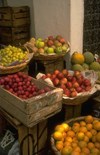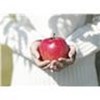Posted 10/12/2011

Farmer's Merket season in the northeast is not over yet! Many markets are still open through October. Check your favorite market's schedule and take advantage of the end of the season bounty.
Download these tips provided by the Farmers' Markets Federation of NY.
Posted 10/6/2011

The appearance of fresh, crisp, local apples at farm stands, harvest festivals, in supermarkets and farmers’ markets signals that the best part of autumn is here. The taste of these juicy specimens spell delicious!
According to the New York Apple Association, New York State is second in the country for apple production, producing more than 25 million bushels of apples each year. Apple trees thrive in New York's climate with plenty of rainfall, good soil and favorable temperatures to grow apples.
Posted 10/5/2011

What variety of apple to choose?
- GINGER GOLD, an excellent eating apple, is available in late summer and early fall.
- HONEYCRISP is sweet and crunchy and excellent for eating raw or in salads.
- CORTLAND was developed at the Cornell Agricultural Geneva Experimental Station and is sweet with a little bit of tartness and is good for eating.
- EMPIRE, also developed by Cornell University, is a cross between a Red Delicious and a McIntosh. It is sweet tart and good for eating and baking.
- IDARED is a crisp apple with a sweet tart taste that is excellent in pies.
- ROME is an old variety, from the 1820s, with a mildly tart flavor and is good for applesauce and baking.
The difference between apples for eating raw and apples for cooking or baking is that apples for eating tend to have a higher sugar content, are generally larger in size and taste better raw than baking or cooking varieties.
Posted 10/5/2011
Posted 10/4/2011
by Roseann Doran

Something sweet is a nice finish to a meal. The calories, however, can add up fast if our desserts contain too much sugar and fat.
On Tuesday, October 18, Cornell Cooperative Extension in Fulton and Montgomery Counties will present “Get Your Just Desserts” from 6:00 to 7:30 pm at the Shirley Luck Senior Center in Johnstown. Participants will learn how to make tasty, lower sugar, lower fat, and healthier desserts.
The class will include sampling and preparing desserts that incorporate fruits, whole grain and other foods that are part of a healthy diet. Take home materials include recipes, tips and guidelines on how to modify recipes for better health. Class size is limited to provide an effective hands-on experience.
To reserve a space in the class, payment must be received before 4:00 p.m. on Monday, October 17. The cost is $15 per person. For more information or to register, call 518-673-5525 x 101.
Posted 10/3/2011

The weather is getting cooler and it is time to wrap up the garden for this year. Yet, you still have some vegetables or fruits to pick. And, what will you do with them?
If you have a freezer, even a small unit, you can freeze some of your bounty to retain that fresh taste for colder days this winter. Freezing fruits and vegetables is easy and the results can be great if you follow some specific instructions.
Download these handy references, newly revised by Cornell Cooperative Extension Food Preservation experts.
Posted 10/3/2011
Posted 9/30/2011
by Roseann Doran
If tomatoes are picked green, how should they be handled to ensure proper ripening and full flavor?
Never refrigerate tomatoes that are picked before they mature. Place clean, dry, green tomatoes in a cardboard box in a single layer, Store them at room temperature, out of direct sunlight and allow them to develop full color. When they are fully ripe, place them in the refrigerator several hours before eating. Tomatoes handled in this manner will be of high quality and full flavor.
Below are some recipes to use green tomatoes.
Posted 9/30/2011
Posted 9/29/2011
by Roseann Doran
The CDC, FDA and other public health officials are continuing to investigate a multistate outbreak of listeriosis traced to whole cantaloupes.
The recalled melons were grown by Jensen Farms in Colorado and distributed under the Rocky Ford label. They were shipped between July 29 and September 19 to at least 25 states including New York. To date the CDC reports 72 people have been infected with Listeria monocytogenes and 13 people have died (none yet in New York). CDC notes: “Although Jensen Farms issued a voluntary recall of Rocky Ford cantaloupes on September 14, CDC expects that cases related to this outbreak may continue to be reported through October, because patients can develop listeriosis up to 2 months after eating contaminated food.”
The following websites provide information related to the outbreak.
Investigation Outbreak – Advice to Consumers, updated September 26, 2011
http://www.cdc.gov/listeria/outbreaks/cantaloupes-jensen-farms/092711/index.html#advice-consumers
Consumer Safety Information on the Recalled Whole Cantaloupes by Jensen Farms, updated September 28, 2011
http://www.fda.gov/Food/FoodSafety/CORENetwork/ucm272372.htm
“The FDA advises consumers not to eat the recalled cantaloupes and to throw them away. Do not try to wash the harmful bacteria off the cantaloupe as contamination may be both on the inside and outside of the cantaloupe. Cutting, slicing and dicing may also transfer harmful bacteria from the fruit’s surface to the fruit’s flesh.”











